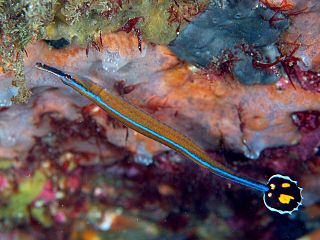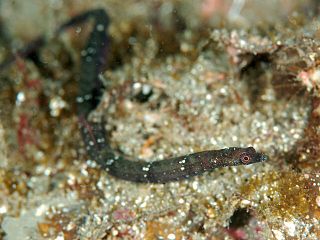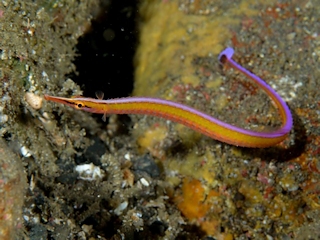
Requiem sharks are sharks of the family Carcharhinidae in the order Carcharhiniformes. They are migratory, live-bearing sharks of warm seas and includes such species as the tiger shark, the spinner shark, the blacknose shark, the blacktip shark, the grey reef shark, the blacktip reef shark, the silky shark, the dusky shark, the blue shark, the copper shark and the oceanic whitetip shark.

The Syngnathidae is a family of fish which includes seahorses, pipefishes, and seadragons. The name is derived from Greek, σύν (syn), meaning "together", and γνάθος (gnathos), meaning "jaw". This fused jaw trait is something the entire family has in common.

Pipefishes or pipe-fishes (Syngnathinae) are a subfamily of small fishes, which, together with the seahorses and seadragons, form the family Syngnathidae.

Syngnathus is a genus of fish in the family Syngnathidae found in marine, brackish and sometimes fresh waters of the Atlantic, Indian and Pacific Ocean. Fossils of these species are found from the Oligocene to the Pleistocene. They are known from various localities of Greece, Italy, Germany and United States.

Doryrhamphus and Dunckerocampus, popularly known as flagtail pipefish, are two genera of fishes in the family Syngnathidae. They are found in warm, relatively shallow waters of the Indo-Pacific, with a single species, D. paulus, in the eastern Pacific. Most of these pipefishes are very colourful, and are fairly popular in the marine aquarium hobby despite requiring special care and not being recommended for beginners.

Corythoichthys is a genus of pipefishes of the family Syngnathidae. All species in the genus are found in the tropical Indian and Pacific Oceans on reefs or rubble bottoms. Relationships and taxonomy within the genus are still in debate, but there may be at least 23 species.

Dunckerocampus is a genus of pipefishes one of two genera known as the flagtail pipefishes. This genus is native to the Indian and Pacific Oceans where they are usually found in reef environments. These species are elongated and have a maximum length between 10 and 20 centimetres, with D. chapmani being the only species with a maximum length below 15 centimetres (5.9 in). Their tail is red with a whitish edge, and in some species there is a white or yellow spot in the center. All except D. baldwini have vertical red/brown and yellow/white stripes on their body.

Doryrhamphus is a genus of pipefishes, one of the two genera colloquially known as flagtail pipefishes and are popular in the aquarium trade. The members of this genus are native to the Indian and Pacific Oceans where they inhabit reef environments. The species in this genus have a maximum length of 14 centimetres (5.5 in) or less, with D. janssi being the only species that surpasses 8.5 centimetres (3.3 in). Most species have a horizontal blue line along their body, and all have a whitish-edged tail that is marked contrastingly with black, red or yellow.

Halicampus is a genus of pipefishes of the family Syngnathidae, containing 12 described species.

Siokunichthys is a genus of pipefishes native to the Indian and Pacific Oceans. One species, Siokunichthys nigrolineatus, has a commensal relationship with mushroom corals of the genus Fungia.
Choeroichthys is a genus of pipefishes of the family Syngnathidae native to the Indian and Pacific Oceans.

Maroubra is a genus of pipefishes with one species, M. perserrata, endemic to Australia and the other, M. yasudai, endemic to Japan.
Micrognathus is a genus of pipefishes, with these currently recognized species:
Minyichthys is a circumtropical genus of pipefishes consisting of species from the Indo-Pacific and eastern and western Atlantic regions. The genus is characterized as having a maximum standard length of about 60 mm, with two or three anal fin rays. Minyichthys species can be differentiated from members of the closely related genus Micrognathus by their higher frequency of total subdorsal rings.
Cosmocampus elucens is a species of marine fish of the family Syngnathidae. It is found in the western Atlantic, off the U.S. east coast, Bermuda, the Bahamas, the Gulf of Mexico, throughout the Caribbean Sea, and off the coast of Brazil. It lives in seagrass and algae beds, typically at shallow depths, where it can grow to lengths of 15 centimetres (5.9 in). It is expected to feed on small crustaceans, similar to other pipefishes. This species is ovoviviparous, with males carrying eggs and giving birth to live young.
Cosmocampus heraldi is a species of marine fish of the family Syngnathidae. It is known from only seven specimens, which were found at the Desventuradas and Juan Fernandez Islands in Chile. It inhabits rocky reefs and sandy areas at depths of 6–23 metres (20–75 ft), where it can grow to lengths of 7 centimetres (2.8 in). It is expected to feed on small crustaceans like other pipefish. This species is ovoviviparous, with males carrying eggs until giving birth to live young. The specific name honours the ichthyologist Earl Stannard Herald (1914-1973) who had a lifelong interest in pipefish.
Cosmocampus hildebrandi is a species of marine fish of the family Syngnathidae. It is found in the western Atlantic Ocean, off of the US coast from North Carolina south to the Gulf of Mexico, off the Yucatan Peninsula (Mexico), and off of northwestern Cuba. It inhabits sandy habitats with seagrass, coral, and rock substrates at depths of 5–75 metres (16–246 ft), where it can grow to lengths of 8.6 centimetres (3.4 in). This species is ovoviviparous, with males carrying eggs and giving birth to live young. The specific name honours the ichthyologist Samuel F. Hildebrand (1883-1949), who first recognised the holotype as being possibly a new species.
Cosmocampus howensis is a species of marine fish of the family Syngnathidae. It is found in the South Pacific from Jervis Bay to Easter Island. It lives in lagoons and on rocky reefs, where it grows to lengths of 10–12 centimetres (3.9–4.7 in). It is expected to feed on small crustaceans, similar to other pipefishes. This species is ovoviviparous, with males carrying eggs before giving birth to live young.
Cosmocampus retropinnis is a species of marine fish of the family Syngnathidae. The name retropinnis comes from the location of the species' dorsal fin as either caudal or posterior. The coloration of this organism is mostly brown and tan markings on its snout side, head's dorsum, side of the trunk, and venter of the tail. It is only known from a few juvenile specimens collected off southern Morocco and Gambia at depths to 79m. Little is known about its feeding habits, but it is expected to feed on small crustaceans, similar to other pipefish. This species is ovoviviparous, with males carrying eggs before giving birth to live young.
Earl Stannard Herald was an American zoologist, Ichthyologist and television presenter. He was born in Phoenix, Arizona, and got his PH.D. in 1943. In 1948, he became the director of the Steinhart Aquarium in San Francisco, California, and from 1952 to 1966, he presented the popular science television programme Science in Action. Throughout his life, he studied a variety of aquatic organisms, especially pipefishes, and described many new taxa. He died in Cabo San Lucas, Baja California, in a scuba diving accident.









